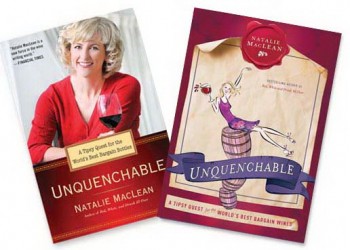After spending the past few years traipsing from one winery to another around the world, Natalie MacLean jokes that she’s “well-preserved — completely pickled.”
The Ottawa-based wine writer says she slogged through a total of 15,267 wines at 312 wineries, to be exact.
And despite protestations that this was “hard work,” MacLean makes it clear that there are worse ways to pass the time than downing fabulous wine with exquisite food in exotic locales.
“I love the hedonism, I love the gorgeous meals you can have, and the relaxation, that gradual loosening of some inhibitions, and the conversation that can flow around it,” she says in an interview.
In her new book “Unquenchable — A Tipsy Quest for the World’s Best Bargain Wines,” MacLean describes in breezy, travelogue style her vineyard visits to Australia’s Barossa Valley, Germany’s Mosel Valley, Ontario’s Niagara region, South Africa’s Cape, Portugal’s Douro Valley, Mendoza in Argentina, Mount Etna in Sicily and Provence, France.
She also recounts her wide-ranging conversations with a colourful cast of winemakers, some high-minded and philosophical, others less so.
“I call this wine the leg-opener,” says pioneering Aussie vintner Wolf Blass — now brand ambassador for products that bear his name — as he pours MacLean a glass of his Red Label Shiraz Cabernet Sauvignon.
Getting to know such characters was the goal, MacLean says.
“Wine’s an excuse for me to be nosy and to get into people’s lives. What I was looking for were great stories about people first, not the best wines.”
MacLean has made a splash in the wine world since switching from a high-tech marketing career 12 years ago. Her previous book, “Red, White, and Drunk All Over” from 2006, was a bestseller, and she says her e-newsletter now has almost 125,000 subscribers.
Despite that success — and the fact that wineries regularly send her free bottles to evaluate — MacLean calls herself a “wine cheapskate,” saying she still gets a thrill from discovering a bargain on liquor store shelves.
But bargain doesn’t necessarily mean cheap. MacLean says Niagara Pinot Noir is “a relative steal” at $25 to $35 a bottle, compared with benchmark products from Burgundy, France. And some wines, which she refers to as “bog-wash” and “vinstrosities,” are not worth drinking at any price.
“I think there is a sweet spot where you can get wines that really do taste twice or three times as expensive as they cost. … For me, it’s in the $12 to $17 range, maybe $20.”
Canadian wineries are faced with a cool climate and other related ills that can push up prices, she says. Still, MacLean rates many of the country’s dry table wines, especially its Rieslings and Pinots, as bargains.
“We have mildew and rot and pests and all kinds of things. But on the flip side, that cool climate produces magnificent wines that have this nervy energy to them.”
Here are some of MacLean’s bargain-hunting tips:
— Take a chance on grapes that lack cachet. For example, think Malbec, not Merlot.
— Instead of fashionable wine-growing areas like Piedmont or Burgundy, check out lesser-known places such as Sicily or Languedoc-Rousillon.
— Chile and Argentina are “terrific bargains,” with wines often less than a quarter the price of comparable ones from Napa, Tuscany and Bordeaux.
— Bottles with “illegible gothic script and impossibly long names” — think German Riesling — can represent a deal. Shoppers are turned off by such labels, so demand is low.
— Search out wines from warm regions, like Barossa, where production costs are often lower than in cooler areas.
— Ten-year-old tawny ports are great values.
You can read more reviews of my new wine book Unquenchable here.









